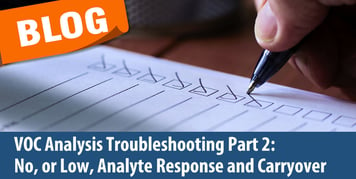
This is the second in our Troubleshooting series for VOC Analysis.
Part one is linked here, VOC Analysis Troubleshooting Part 1: How to Begin Troubleshooting
Part 2 will discuss No, or Low, Analyte Response and Carryover.
Troubleshooting your instruments can be a frustrating process, but I hope this series eases some of that pain and helps you through it. If you’re dealing with no or low response from your analytes, you first need to know if the analytes are even getting to the Gas Chromatograph and Mass Spectrometer (GC-MS). Following the advice in part one of this series, start with a direct injection into the GC of the same standards you use on your Purge and Trap (P&T), to confirm normal operation of the GC-MS. If you see poor chromatography and resolution or reduced response, you should change your inlet liner and clip the column.
Once the GC-MS is eliminated as the source of the issue, you can proceed to the P&T.
- First, on the P&T and autosampler side, make sure the sample is being pulled and transferring to the sparger.
- If you don’t see the correct amount in the syringe or sparger, the sample valve or drain valve could be leaking across the port of the valve and you might not get the sample recovery you’re expecting.
- If you don’t see any bubbles in your sparger, then perform a leak check and double check your gas tank regulator pressure gauge.
Regulators are typically set to 65-85 psi for P&T systems and GC-MS. If the leak check passes, make sure your purge flow is set correctly in your method. Typical US EPA methods have guidelines for this parameter; they usually want you to purge for 11 minutes at 40 ml/min. While you’re checking your method, make sure you have the correct desorb flow settings for your trap; if this is set wrong, all your analytes might not be getting off the trap.
- Next, while a sample is in desorb, check the status screen and make sure the trap heater is reaching the correct temperature set-point to ensure the analytes are getting off the trap.
- Last, you can check your mass flow controller. Measure the flow out of the vent on the manifold by setting the flow in the valves and flows section of the tools menu in TekLink. Set the flow to 40 ml/min and make sure your flow meter is within a few ml/min of this set point. Or, you could measure this while a sample is in purge.
Carryover is not just for late-eluting compounds; it could regard the full target list. To track this down on the GC-MS side:
- Set up a GC-only run. This chromatogram will show you if the carryover is in your GC. Identify what peaks you are seeing. If it’s carryover, it could be causing your results to be more than they should be.
For the P&T:
- Click Go To Desorb in TekLink’s tools menu to preheat the trap and desorb to the GC-MS. This will help you identify if anything is staying on the trap longer than it should. If temperatures are not getting to the set point, analytes might not be desorbing off the trap and be carrying over to the next sample.
- Double check your bake temperature and flow in your method, because bake is a very important step for cleaning up the system and preventing carryover from sample to sample.
- Last, make sure the hot water and methanol rinses are working correctly. Another important step to cleaning your system is pushing enough 90°C water through your sample pathway to clean it.
If the carryover you are seeing is of the full target list, you could have a faulty electronic pneumatic controller (EPC) on the GC-MS. On the P&T, a valve could be leaking to a part of the instrument that is not going to be used until the next sample, and it then gets swept into the following sample that’s on its way to the sparger. If the drain line in the sparger isn’t all the way down to the frit, it may not be draining properly and leaving sample to be carried over to the next sample.Finally, the simple answer could be that the glassware is dirty and needs to be cleaned or replaced.
For carryover of the late eluting compounds, you could have a cold spot on your GC inlet and compounds could be gathering there, waiting to be sent with the following sample. On the P&T, make sure you have enough bake time in the method. You could set up an optimization study and compare a range of bake times. In the autosampler, you might need to set up more bake rinses. It is possible the sample needle is not being cleaned properly. Check this by witnessing the bake rinses being transferred over to the P&T.
Please follow this series as we cover a range of tips and tools that can help you through the troubleshooting process.
- Part one is linked here, VOC Analysis Troubleshooting Part 1: How to Begin Troubleshooting
For more information, click the button below.
